Burke
-
- Catching up with Vice Adm. William Burke (Ret.) Maritime Logistics Professional, Q1 2014 #20
Chief Maritime Officer and EVP, Carnival Corporation & PLC
When Vice Admiral (ret) Burke joined Carnival Corporation & plc in December of 2013 as Executive Vice President and Chief Maritime Officer of Corporate Maritime Operations, it is likely that the way cruise ship lines do business may have changed forever. That’s because the newly created position, where Burke is responsible for driving the company’s commitment to safety, has its focus – in Burke’s own words – “driven solely by the commitment to safety and not necessarily influenced by other things.”
Burke graduated from the United States Naval Academy with a Bachelor of Science in Systems Engineering and has since completed his MBA and numerous other higher education honors. The oldest of nine children, Burke went to the U.S. Naval Academy thinking he could get a good education on the cheap and give his brothers and sisters other opportunities. Interestingly, his next two brothers attended the school, as well.
During a long and distinguished naval career, Burke served on five submarines including command of USS Toledo (SSN 769) and his Washington, DC assignments include tours in the Navy Office of Legislative Affairs, Joint Chiefs of Staff directorate for Combating Terrorism, Navy Warfighting Assessments Branch, and as the Executive Assistant to the Vice Chief of Naval Operations. Burke’s flag assignments have taken him just about everywhere else, including command of the Logistics Group Western Pacific in Singapore.
Perhaps most important to his fit for the current billet, Burke became a submarine commodore where he had as many as six submarines in his squadron. “I spent a good bit of my time riding those submarines helping them try to get better and improve training, both from a deck and a technical perspective. I think one of the reasons Carnival wanted to hire me is that from the standpoint of a nuclear submariner, I understand both the deck and technical sides of the equation, which as you know, is quite different from the cruise and merchant side of the equation. And, my other billets tended to be focused more on logistics and the broader navy.” Burke is clearly right at home in his new role, adding, “I was fortunate enough to find a job which was exactly what I was looking for. It’s a place I can make a difference, I don’t have throw out everything I’ve learned before and at the same time, there is much more for me learn.”
A Job like Nothing Else
Chief Maritime Officer is a position like no other in the commercial maritime world. But Carnival, already with an arguably enviable safety record over time, nevertheless was looking to step up its environmental, safety and operating efficiency footprint up another notch. Burke told MarPro in February, “This is something that has been brewing for a while, and it was the board’s wish that we have someone whose focus is driven solely by the commitment to safety and not necessarily influenced by other things.” That sounds simple enough, but as Burke explained further, there are a lot of pieces to that effort. “Certainly, there was safety, security, environmental, health, but there’s also the right kind of maintenance at the right time; it’s about building ships that incorporate lessons learned and it is about how we train our people.” The role is more operational than administrative and Burke has already spent time with the Executive Vice Presidents of each of the operating lines, outlining plans to improve performance in the broader safety, health, security and maintenance areas. And, he’s spent time at sea, watching the bridge teams interact with one another and with the pilot. “The job is very operational and I love getting to be able to get back to sea again,” says Burke.
On the Job: Job ONE
Burke today reports to Carnival COO Alan Buckelew. In the new role, his performance will be benchmarked against several measurable criteria. And, Burke hit the ground running in December. “We’re trying to make sure we don’t have major fires. We’re working hard on getting the right prevention and suppression systems in place. Part of that is training: teaching the crew how to use their gear, when to use it and not to be afraid to use it. Carnival instituted formal bridge resource management procedures a couple of years ago and from what I’ve seen, it is working very well. Part of that is getting away from the master who is autocratic and dictatorial and where his subordinates are unwilling to question what he does. The bridge officers need to work as a team and I see progress on that. Clearly, the company is focused on health, safety and the environmental issues – otherwise, they wouldn’t have hired me for this position.”
Cross Training & New Opportunities
Burke’s value to his new employer runs far deeper than simple experience and/or skill sets. That’s because the U.S. Navy and the global merchant fleets do things differently. Burke sees opportunities for his deck and engine crews to learn lessons from his military counterparts and, he says, there are more than a few things that the Navy could learn from the commercial sector. He explains, “Today, there’s a far greater reliance on technology than you and I may have seen years ago. In both places, there are people who are reluctant to go to electronic chart system, but that’s changing. One of the things the Navy does better than the cruise industry is train – in simulators, putting mariners in situations where they can learn about things without putting the ship in danger. They also train routinely on the ships. Navy personnel are usually very comfortable with high intensity, casualty situations on board navy ships.” Conversely, he says, that can’t be done on a cruise ship because you don’t want to disturb the passengers, adding, “In the cruise industry, it will important that we rely on simulation. And we at Carnival have a pretty good program going in that regard. We recently made the decision that we would go to annual, reoccurring training for our bridge and technical officers. I can’t emphasize enough how important that is – to be able to put people in situations that are not real but seem real. That’s important training and I’m pleased to see that we are on that track here at Carnival. One of the things the Navy could do better is that – looking at the cruise industry – they don’t have people walking all over each other. So, there’s opportunity to learn from sides of the equation.”
Drilling down even further, Burke says that the differences between the cruise line business model and that of the tanker and bulk sectors are, in some cases, even starker. Operating from the premise that ‘mariners are mariners,’ no matter what their role or sector, Burke insists that there are common skill sets that each of these professionals must have, in order to be successful. “We do not operate in a benign environment. So, we must keep the necessary precautions to keep our ship safe. Both navy and merchant ships operate complex equipment in a challenging environment. Things sometimes break and sometimes they break catastrophically. We need to stay ahead of that, we need to do the proper maintenance and we need to stand a proper watch. When bad things happen, we need to investigate, learn the root causes, fix them and get better. That’s standard across all mariner missions – I think all mariners should feel the same way about that.” Across the many fleet brands under the larger Carnival corporate structure, Burke reports that deck officers are comprised chiefly of European mariners; Dutch, UK, and Italian nationals. He clearly thinks a lot of the professionals at Carnival, but didn’t rule out changes to that mix, saying, “I’ve been approached by some of the U.S. maritime academies and I think there is a good opportunity to get Americans into these roles. It’s a great idea, and I hope we succeed in that effort.”
Navigating the Regulatory Environment
As 2013 came to a close, the U.S. Coast Guard had nearly 70 regulatory efforts in play, with the IMO and numerous local U.S. states brewing up their own additions to the mix. Looming large for Carnival in terms of compliance issues, stack emissions are high on the list. To that end, Burke says, “We’re working pretty hard on scrubber technology installations. If we get it right, it will allow us to operate around the world. Secondly, we’re concerned about overboard discharges. We need to well in this area; if not, we’re going to hinder our ability to operate in areas where we want to be. I will say that in military, we regulated ourselves very tightly so that no one could question what we did.” And, he adds, Carnival will do the exact same thing.
Part of the Carnival environmental and safety strategy, going forward, include remote monitoring. Burke admits, “We’re not doing much now, but we are looking into it. We want to see if the ships are doing the things they should be doing, and we’re looking to create a culture that reduces the chance of untoward incidents.” He says that doing ‘the right amount of maintenance at the right time,’ is also a key part of that journey, adding, “By monitoring those parameters and we are at the very beginning of that journey, we can achieve those goals.”
Burke says that he has always been a champion of doing the right maintenance at the right time. “It’s more important to take care of the ships we have because we’re going to have them for a long, long time. There’s a big cost in buying those ships and a large cost in owning them. If you want them to get to their expected life, you need to take care of them. And what we found in the navy is that 75 percent of what you spend on a ship, you need to spend whether you put it to sleep or not. You don’t have to do too much maintenance, but you have to do it at the right time.” Beyond the technology that is certainly coming, you get the distinct impress that Burke will monitor that situation closely, as well.
From a safety perspective, Burke says that the greater Carnival brand and its many fleets do have a good record. To that end, he says, “We’re working hard to improve it. People assume that ships are going to be safe – that’s a fair assumption. My goal in the near term would be to have (as much) installation complete on the fire prevention, suppression and detection equipment as we possibly can across the fleet.”
Smart Thinking, Global Savvy
For Carnival and Bill Burke, the gleaming outward appearance of their collective, international fleets is meaningless without the back office resolve to commit every possible resource towards the safest, most efficient organization possible. At the heart of all of that, perhaps, is CSMART, the Center for Simulator Maritime Training, a facility located in Almere, Netherlands. A service mark of Carnival plc, CSMART operates as the Dutch branch of Carnival plc, which is part of the Carnival Corporation & plc group. There, the journey to the best possible Carnival Corporation has already begun. Burke says, “We’ve just made the decision to go to annual reoccurring training, which will require us to expand our facility.” When that happens, says Burke, every single officer in the fleet will see simulation training, every year, preparing for every possible outcome at sea.
Training should, according to Burke, go far beyond simple simulation exercises. “One size does not fit all. There’s a great opportunity for the ‘commodore chief’ to train those folks and recognize the differences. My time spent in Singapore was also quite valuable in that I participated in quite a few exercises with people from many nationalities that exposed me to different cultures that I worked with. That helps me a great deal with my work here at Carnival where, to a large extent, there many cultures because we are a large, multi-national corporation. We operate different lines, all over the world.”
The multi-cultural, multi-faceted and diverse fleets of the Carnival Corporation now have a multi-talented, globally savvy and pressure-tested Chief Maritime Officer. By doing so, Carnival has redefined the business model of the modern cruise industry. What comes next might just surprise you. But as you get to know William Burke, it shouldn’t.
(As published in the 1Q 2014 edition of Maritime Professional - www.maritimeprofessional.com)
-
- 'Arleigh Burke,' First Aegis Destroyer, Conducts Weapons Trials In Atlantic Maritime Reporter, Mar 1991 #41
The new Aegis destroyer Arleigh Burke (DDG-51), the lead vessel in what has been termed the U.S. Navy's ship of the 21st century, continued to live up to its advance billing when it recently engaged in weapons trials in the North Atlantic. Featured on this month's cover of the "Naval Technology &
-
- Crowley Maritime Names Sean G. Burke President, Atlantic Division Maritime Reporter, Jan 1989 #34
Crowley Maritime Corporation, a diversified marine transportation firm with worldwide operations, has named Sean G. Burke as president, Atlantic Division, according to a recent announcement by Leo L. Collar, Crowley's president and chief operating officer. Mr. Burke was most recently senior vice
-
- General Electric To Supply Machinery Control System For Navy Destroyer Burke Maritime Reporter, Aug 1985 #14
—Literature Available General Electric Company has been chosen to provide the machinery control system for the first of the U.S. Navy's new Arleigh Burke Class guided missile destroyer (DDG-51). Under this contract, GE's Simulation and Control Systems Department in Daytona Beach, Fla., will design
-
- Dravo Corporation Names M.B. Meyer And J.J. Burke Maritime Reporter, May 15, 1977 #6
, Far East, for Dravo International, with responsibility for spearheading and coordinating Dravo Corporation's marketing activities in that area. J.J. Burke, formerly Dravo's regional marketing manager, Far East, will assist Mr. Meyer as general marketing manager. Mr. Meyer was appointed Dravo's corporate
-
- VTHE NEW DDG-51 CLASS GUIDED MISSILE DESTROYERS —A Report— Maritime Reporter, Jun 1985 #80
When the Navy announced on 2 April that Bath Iron Works had won the competition to build the first of the new DDG-51 (Arleigh Burkeclass) Aegis guided missile destroyers it meant—for the Navy, and for the U.S. shipbuilding industry as well—the end of a very long wait. The reason for the shipbuilders'
-
- An Artistic Interpretation Maritime Reporter, Jun 2001 #84
as the ship breaks through heavy seas. The number on her bow — 85 — disappears and reappears with each crest of the waves. Suddenly above the Arleigh Burke-class guided missile destroyer, as if it had traveled through a time portal, screams a Grumman F6F-5 Hellcat — a World War II fighter. Painted on
-
- USS Roosevelt Is Commissioned At Mayport Maritime Reporter, Jan 2001 #24
The nation's 30th Arleigh Burke class Destroyer, USS Roosevelt, was commissioned on October 14 at Mayport Naval Station Florida. Roosevelt is the premiere Ingalls-built Flight IIA destroyer, a variant of the Burke Class with full up helo facilities, carrying up to two SH-60B Seahawk helicopters. The
-
- House Subcommittee Looks To Open Competition To Build Fourth Aegis Destroyer Maritime Reporter, Jul 1988 #33
a fourth Aegis destroyer. The Senate recently amended the FY 1989 defense authorization bill to authorize the Navy to purchase a fourth DDG-51 Arleigh Burke Class destroyer, without appropriating additional funding for the ship. The Navy was authorized by the Senate to use as much as $730 million of funds
-
- U.S. Navy: DDG(X) is a Large Surface Combatant with Room to Grow Maritime Reporter, Feb 2022 #34
every mission area. Meanwhile, the threat marches on.”Rear Adm. Paul Schlise, director for surface warfareThe U.S. Navy’s highly successful USS Arleigh Burke (DDG 51) surface combatant program is still going strong and growing in capability. Nearly 40 years later, new ships are still being built. But,
-
- MAJOR NAVY CONTRACTS Maritime Reporter, Mar 1991 #39
(N00024-91-C-2120). Bath Iron Works Corporation, Bath. Maine, was awarded a $72,489,781 costplus- award-fee contract for lead yard services for Arleigh Burke-class Aegis destroyers. Work is expected to be completed in November 1991. The Naval Sea Systems Command, Washington, D.C., is the contracting activity
-
- First Allison Gas Turbine Genset Shipped For DDG-51 Installation Maritime Reporter, May 1989 #48
Allison Gas Turbine's new generator sets has been shipped to Bath Iron Works, Bath, Maine, for installation in the lead ship of the U.S. Navy's Arleigh Burke (DDG-51) Class destroyers. The model AG9130 ship service gas turbine generator will provide all shipboard electrical power on the new destroyers
-
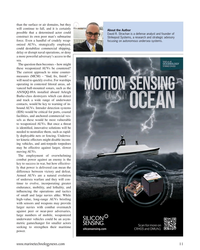 )
January 2024 - Marine Technology Reporter page: 11
)
January 2024 - Marine Technology Reporter page: 11to quickly evolve. For warships operating in contested littoral areas, ad- vanced hull-mounted sonars, such as the AN/SQQ-89A installed aboard Arleigh Burke-class destroyers which can detect and track a wide range of underwater contacts, would be key to warning of in- bound AUVs. Intruder detection systems
-
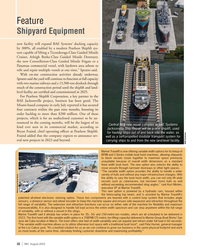 )
August 2023 - Marine News page: 32
)
August 2023 - Marine News page: 32docking capacity by 300%, all enabled by a modern Pearlson Shiplift sys- tem capable of lifting a Ticonderoga-Class Guided Missile Cruiser, Arleigh Burke-Class Guided Missile Destroyer, the new Constellation-Class Guided Missile Frigate or a Panamax commercial vessel, with laydown area ashore to re
-
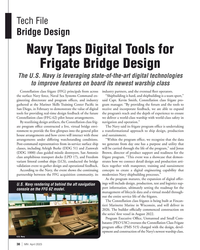 )
April 2023 - Marine News page: 38
)
April 2023 - Marine News page: 38the data Post-command representatives from in-service surface ship we generate from day one has a purpose and utility that classes, including Arleigh Burke (DDG 51) and Zumwalt will be carried through the life of the program,” said Jonas (DDG 1000) class guided missile destroyers, San Antonio Brown
-
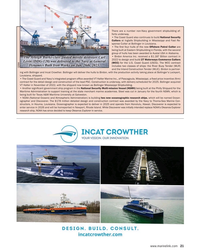 )
February 2023 - Maritime Reporter and Engineering News page: 21
)
February 2023 - Maritime Reporter and Engineering News page: 21, with the second group of hulls has been awarded to Austal USA in Alabama. • Birdon America Inc. received a $1.187 Billion contract in The Arleigh Burke-class guided missile destroyer Carl 2022 to design and build 27 Waterways Commerce Cutters Levin (DDG-120) was delivered to the Navy at General (WCC)
-
 )
February 2023 - Maritime Reporter and Engineering News page: 18
)
February 2023 - Maritime Reporter and Engineering News page: 18of about 355 ships, plus a ? eet of about 150 per year,” he said, referring to the three-per-year desired pro- unmanned vessels duction rate for Arleigh Burke-class guided missile destroy- But to achieve something close to that goal requires more ers, as well as the two-per-year desired production rate for
-
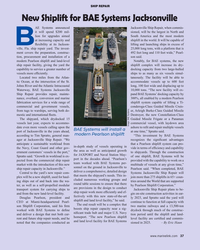 )
January 2023 - Maritime Reporter and Engineering News page: 37
)
January 2023 - Maritime Reporter and Engineering News page: 37capable of lifting a Ti- commercial and government vessels, conderoga-Class Guided Missile Cruis- from tugs to warships, serving both do- er, Arleigh Burke-Class Guided Missile mestic and international ? eets. Destroyer, the new Constellation-Class The shipyard, which drydocked 15 Guided Missile Frigate
-
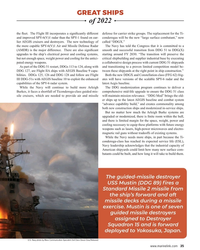 )
December 2022 - Maritime Reporter and Engineering News page: 35
)
December 2022 - Maritime Reporter and Engineering News page: 35of the SPY-6 radar system. latest Aegis baseline. While the Navy will continue to build more Arleigh The DDG modernization program continues to deliver a Burkes, it faces a shortfall of Ticonderoga-class guided mis- comprehensive mid-life upgrade to ensure the DDG 51 class sile cruisers, which are needed
-
 )
December 2022 - Maritime Reporter and Engineering News page: 34
)
December 2022 - Maritime Reporter and Engineering News page: 34GREAT SHIPS of 2022 he USS Arleigh Burke (DDG 51) class of guided separate Propylene glycol and water (PGW) cooling system missile destroyers can rightfully be called the for the SPY-6 radar. most successful class of surface combatants in the The ? rst of the Flight III DDGs is the future USS Jack H.
-
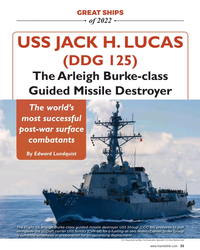 )
December 2022 - Maritime Reporter and Engineering News page: 33
)
December 2022 - Maritime Reporter and Engineering News page: 33GREAT SHIPS of 2022 USS JACK H. LUCAS (DDG 125) The Arleigh Burke-class Guided Missile Destroyer The world’s most successful post-war surface combatants By Edward Lundquist The Flight IIA Arleigh Burke-class guided-missile destroyer USS Shoup (DDG 86) prepares to pull alongside the aircraft carrier
-
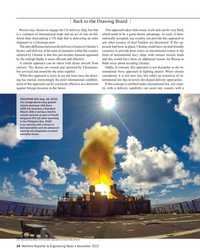 )
November 2022 - Maritime Reporter and Engineering News page: 24
)
November 2022 - Maritime Reporter and Engineering News page: 24waters in the selected by Ukraine is that this just-in-time Amazon approach form of international navy ships with various missile loads by the Arleigh Burke is more ef? cient and effective. and this would have been an additional reason for Russia to A similar approach can be taken with drone aircraft
-
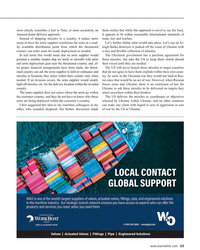 )
November 2022 - Maritime Reporter and Engineering News page: 23
)
November 2022 - Maritime Reporter and Engineering News page: 23the arms at a read- Let’s further de? ne what would take place. Let’s say an Ar- ily available distribution point from which the threatened leigh Burke destroyer is parked off the coast of Ukraine with country can order arms for ready deployment as needed. a nice and ? exible collection of missiles
-
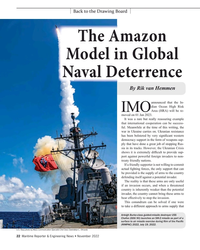 )
November 2022 - Maritime Reporter and Engineering News page: 22
)
November 2022 - Maritime Reporter and Engineering News page: 22these arms to bear effectively to stop the invasion. This conundrum can be solved if one were to take a different approach to arms supply that Arleigh Burke-class guided-missile destroyer USS Chafee (DDG 90) launches an SM-2 missile as part of a surface to air missile exercise during Rim of the Paci?
-
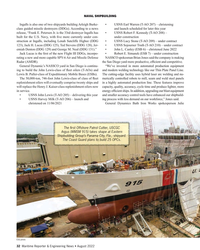 )
August 2022 - Maritime Reporter and Engineering News page: 32
)
August 2022 - Maritime Reporter and Engineering News page: 32NAVAL SHIPBUILDING Ingalls is also one of two shipyards building Arleigh Burke- • USNS Earl Warren (T-AO 207) – christening class guided missile destroyers (DDGs). According to a news and launch scheduled for later this year release, “Frank E. Petersen Jr. is the 33rd destroyer Ingalls has • USNS
-
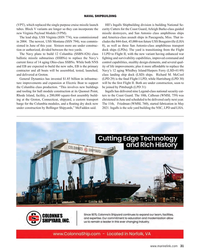 )
August 2022 - Maritime Reporter and Engineering News page: 31
)
August 2022 - Maritime Reporter and Engineering News page: 31Shipbuilding division is building National Se- tubes. Block V variants are longer so they can incorporate the curity Cutters for the Coast Guard, Arleigh Burke-class guided new Virginia Payload Module (VPM). missile destroyers, and San Antonio class amphibious ships The lead ship, USS Virginia (SSN 774)
-
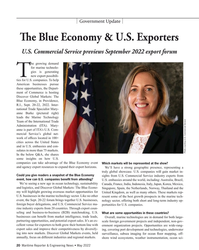 )
May 2022 - Maritime Reporter and Engineering News page: 20
)
May 2022 - Maritime Reporter and Engineering News page: 20of Commerce is hosting Discover Global Markets: The Blue Economy, in Providence, R.I., Sept. 20-22, 2022. Inter- national Trade Specialist Mary- anne Burke (pictured right) leads the Marine Technology Team of the International Trade Administration (ITA). Mary- anne is part of ITA’s U.S. Com- mercial
-
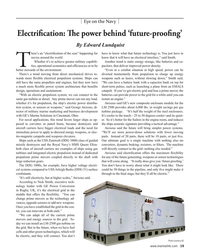 )
May 2022 - Maritime Reporter and Engineering News page: 19
)
May 2022 - Maritime Reporter and Engineering News page: 19DDG 1000s, for example, have higher voltage electri- You don’t have to worry about what it might look like. There cal systems compared to USS Arleigh Burke (DDG 51) surface could be 50 things in the pipeline, and only ? ve might make it combatants. through to the ? nal stage, but they’ll all be electric
-
 )
February 2022 - Maritime Reporter and Engineering News page: 37
)
February 2022 - Maritime Reporter and Engineering News page: 37need to look to the future.” and will form the software foundation for the future.” While Navy leadership is solidly supporting DDG(X), there The Arleigh Burke-class of may be a need to keep the DDG-51 production line going. Guided Missile Destroyers Speaking at a U.S. Navy Memorial SITREP presentation
-
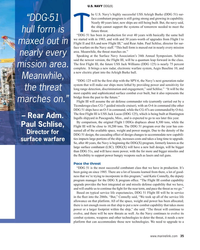 )
February 2022 - Maritime Reporter and Engineering News page: 35
)
February 2022 - Maritime Reporter and Engineering News page: 35U.S. NAVY DDG(X) he U.S. Navy’s highly successful USS Arleigh Burke (DDG 51) sur- face combatant program is still going strong and growing in capability. “DDG-51 Nearly 40 years later, new ships are still being built. But, the navy said, the ship cannot support the systems of tomorrow needed to meet
-
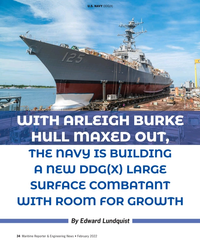 )
February 2022 - Maritime Reporter and Engineering News page: 34
)
February 2022 - Maritime Reporter and Engineering News page: 34U.S. NAVY DDG(X) Photo courtesy HII WITH ARLEIGH BURKE HULL MAXED OUT, THE NAVY IS BUILDING A NEW DDG(X) LARGE SURFACE COMBATANT WITH ROOM FOR GROWTH By Edward Lundquist 34 Maritime Reporter & Engineering News • February 2022 MR #2 (34-49).indd 34 2/4/2022 9:39:41 AM
-
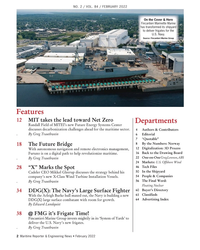 )
February 2022 - Maritime Reporter and Engineering News page: 2
)
February 2022 - Maritime Reporter and Engineering News page: 2Final Word: . By Greg Trauthwein Floating Nuclear 60 Buyer’s Directory 34 DDG(X): The Navy’s Large Surface Fighter 61 Classifieds With the Arleigh Burke hull maxed out, the Navy is building a new 64 Advertising Index DDG(X) large surface combatant with room for growth. By Edward Lundquist 38 @
-
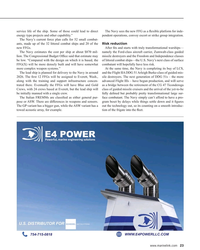 )
November 2021 - Maritime Reporter and Engineering News page: 23
)
November 2021 - Maritime Reporter and Engineering News page: 23.” At the same time, the Navy is completing its buy of LCS, The lead ship is planned for delivery to the Navy in around and the Flight IIA DDG 51 Arleigh Burke-class of guided mis- 2026. The ? rst 12 FFGs will be assigned to Everett, Wash., sile destroyers. The next generation of DDG 51s – the more along
-
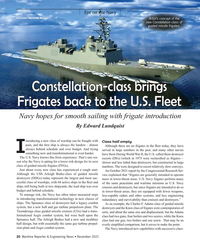 )
November 2021 - Maritime Reporter and Engineering News page: 20
)
November 2021 - Maritime Reporter and Engineering News page: 20convoys. Just about every new class has experienced a rough start. An October 2021 report by the Congressional Research Ser- Although the USS Arleigh Burke-class of guided missile vice explained that “frigates are generally intended to operate destroyers (DDGs) today represent the largest and most suc- more
-
 )
October 2021 - Marine News page: 54
)
October 2021 - Marine News page: 54execution of cus- The story of Vane Brothers began in 1898, when Cap- tomers’ projects. It owns the largest ? eet of deck and spud tain William Burke Vane and his brother, Captain Allen barges in the U.S., ranging from a 400’x100’ oceangoing P. Vane, established a ship chandlery (providing nautical
-
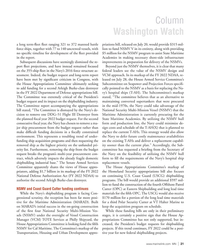 )
September 2021 - Marine News page: 21
)
September 2021 - Marine News page: 21the House Appropriations Committee ultimately seeking Subcommittee on Seapower and Projection Forces speci? - to add funding for a second Arleigh Burke-class destroyer cally pointed to the NSMV as a basis for replacing the Na- in the FY 2022 Department of Defense appropriations bill. vy’s hospital
